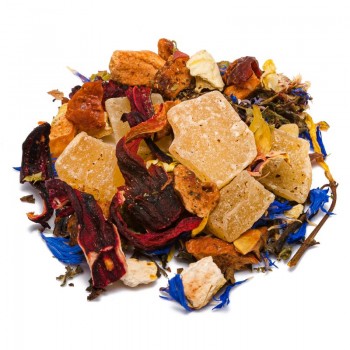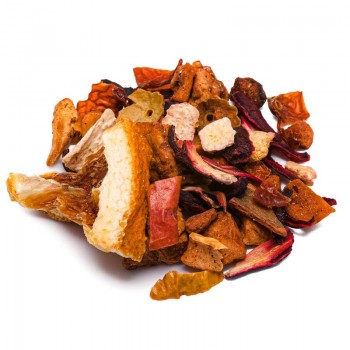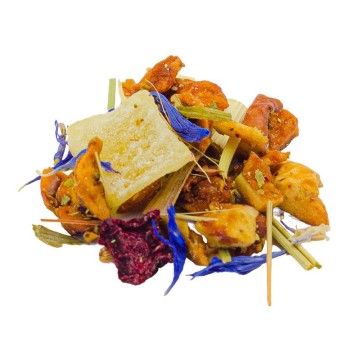This infusion ensures a pleasant lively harmony, with many different ingredients in the blend of fruits, flowers, leaves and white tea. Perfect as a hot drink, strengthening energy levels and the system of our natural defenses. The white tea leaves with lively and fresh flavor nuances combine with the aromatic and delicate floral notes (rose and cornflower). Shades of flavor that are mixed with tasty and sweet fruits, with herbs with a varied flavor and aromas from exotic to citrus.
Mango and grapefruit infusion: properties and benefits
Thanks to this drink, you can obtain vitamins A, B and C, fruit acids and minerals. All bioactive principles, useful for giving strength and energy to our body. The mixture of ingredients is wide, considered useful especially for mango and citrus fruits for restorative purposes. When you experience physical weakness, during seasonal changes or during convalescence, this "booster" of vitamins and energy is useful.
The mango vitamin complex relieves tiredness and provides good support to the immune system. Other fruits rich in vitamins and antioxidants such as papaya, grapes, lemon and melon also contribute to this purpose. In addition to rose petals and cornflower, which provide flavonoids and antioxidants. Mao Feng white tea is also rare and valuable, and represents a source of antioxidants and amino acids. In the mango and grapefruit infusion, the beneficial properties of the mango provide a high content of mineral salts, vitamins and other trace elements. This tropical fruit is known as an excellent antioxidant and stimulant of cardiac circulation, for the well-being of the heart.
The benefits of the antioxidant properties are to be linked to the anti-aging virtues against aging and for the well-being of the body's cells. A further particular addition to the drink is jiaogulan, an oriental plant rich in saponins, antioxidants and amino acids. Also called blue ginger, it has properties that regulate blood pressure and strengthen the immune system – mixed with mango and tropical fruits. Furthermore, citrus fruits and the exotic fruits mango and pineapple provide slightly laxative and diuretic properties, for a detox effect. The advantages can also be found in improved digestion, alleviating the condition of constipation and water retention.
Apple and white tea promote the correct assimilation of food while lemon balm has anti-spasm functions on the gastrointestinal and genitourinary tract. Another exotic and digestive ingredient of the infusion is papaya, which provides precious substances for the digestive system, as well as providing vitamins and minerals. The different fruits, with their load of antioxidants, vitamins and precious minerals, become effective for hydrating and providing a useful infusion for purifying and slimming diets. Suitable for people who suffer from overweight or obesity, the infusion is low in calories. It contains essential nutrients that promote weight loss – if well combined with the diet – such as pineapple and white tea. A good infusion, made up of these ingredients mixed well together, has a more than positive effect on our body.
Origins and history of cultivation
The mango fruit originates from the Mangifera indica plant, which originated in the territories of Southeast Asia and India - it is the same family as the cashew and pistachio. References to the mango are documented in Hindu texts dating back to 4000 BC, as it was a sacred fruit to this cult. Over the centuries, Buddhist monks cultivated it and it was considered an important fruit throughout the region: it is said that Buddha himself meditated under a mango tree.
Starting from 400 AD. approximately, mango seeds have reached the Middle East, East Africa and South America over time. It was Portuguese explorers who gave the fruit its current name, derived from the Indian Tamil phrase maangai, which in Portuguese became "manga" and then mango. To grow at its best, the plant always needs a tropical climate, so today it thrives in these areas of the planet. In Europe it is cultivated in Spain (Andalusia) and Sicily. Over time, many varieties have been developed by growers all over the world.
Fruits and flowers
Some of the main ingredients of the mixture. Mango comes from the Mangifera indica plant, an evergreen of the Anacardiaceae family. Native to southern Asia, the plant has pointed leaves and pinkish-white or yellowish flowers. The fruits are few compared to the flowersi, and require three to six months to mature, depending on the variety of Mangifera cultivated. The fruits are drupes with yellow to green to red-green skin. They give a tender and yellow pulp, and are variable in size, even considerable.
The Carica papaya is a not very large tree of the Caricaceae family. It grows with little branching, up to 10 meters in height if it finds suitable soil and a warm - temperate temperature. The flowers grow continuously, even at the same time as the fruits. The color of the fruits can have various shades between green, yellow, orange or pink. The Rose is a perennial plant of the Rosaceae family. Known for its beautiful flowers, it has developed over three hundred species and thousands of cultivars over time. Most species are native to Asia. The petals are used in infusions. Ananas comosus is a fruit plant of the Bromeliaceae family. It grows best on well-drained soil, with excellent sun exposure. It is not very tall and develops slowly (even 2 years to reach full maturity). The purple, pink or red flowers, together with the berries of the plant, form a single fruit with a shape that resembles a pine cone. The apple fruit comes from the Malus domestica plant belonging to the Rosaceae family. It is native to Asia and has now spread throughout the planet for many centuries. The fruits can grow with various colors based on the many varieties - yellow, red, green apples - to be used in food. Jiaogulan is Gynostemma pentaphyllum, a herbaceous and climbing plant of the Cucurbitaceae family. Native to Asia, jiaogulan is a herbaceous plant considered medicinal. It looks like a small vine, with dark green leaves used for decoctions. It blooms from mid-spring to autumn, with light yellow flowers that give rise to black berries. The tea plant is the perennial Camellia sinensis. A shrub with bright green oval leaves. White tea comes from less common varieties, 90% of which come from the Fujian province of China. The process involves harvesting the shoots still covered by a fine white fleece, leaving them to wither and dry in the sun. Mao Feng is considered one of the five best teas in China.
Nutritional values of mango and grapefruit infusion
The infusion contains various nutrients including minerals, amino acids, vitamin A and vitamin C, group B vitamins. It also makes various antioxidants and substances such as mangaferin and papain available.
How to use the ingredients in the infusion The infusion is obtained by inserting approximately 3-5 grams of the based mixture into a cup (250 ml) of mango, with water at 100 °C. Leave to infuse for 10 to 12 minutes before drinking. Add honey or sugar, if desired.
Mango and grapefruit infusion: side effects and contraindications
It is necessary to respect the recommended doses and not exceed the intake of the infusion for too long periods. Excessive consumption can cause diarrhea, gastric acidity, headache and nausea, low blood pressure.











 No reward points for this product.
No reward points for this product.



![infuso lime mirtilli rossi [Natura d'Oriente]](https://www.naturadoriente.com/3551-home_default/lime-infused-cranberries.jpg)











![infuso pesca melone [Natura d'Oriente]](https://www.naturadoriente.com/3535-home_default/infused-peach-melon.jpg)